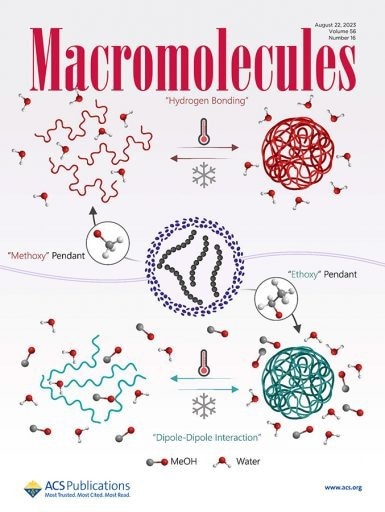Currently, synthetic polymers are extremely common—these are chains of molecular structures designed by scientists to serve a multitude of purposes.
 Chung and Saha’s article was featured on the cover of the Macromolecules in the journal’s August 23rd, 2023. Image Credit: Macromolecules.
Chung and Saha’s article was featured on the cover of the Macromolecules in the journal’s August 23rd, 2023. Image Credit: Macromolecules.
Scientists at the FAMU-FSU College of Engineering have created a pair of closely related polymers that exhibit different responses to varying temperature thresholds despite their similar design. These polymers hold promise for diverse applications, ranging from medical uses and protein synthesis to protective coatings and various other fields. The study was published in the journal Macromolecules.
Typically, in order to have one thermal behavior, we have to prepare a polymer for that specific application, and if you want to have another extreme of polymer behavior, then you have to prepare a completely different polymer. But now, through this work, we have a single type of polymer that can be quickly adapted with minimal interference for both jobs.
Hoyong Chung, Study Author and Associate Professor, College of Engineering, Florida State University
The scientists’ polymer is constructed using sulfoxide, a compound composed of sulfur, oxygen, and carbon molecules. In one version, an additional component is integrated—a methylene group consisting of a pair of hydrogen atoms. This minor structural alteration is sufficient to elicit distinct temperature-responsive behaviors from each polymer.
In every mixture, there exist specific critical temperatures at which the components will fully dissolve into a solution, irrespective of the concentrations of these components within the mixture.
Regarding the researchers’ polymer, one variant exhibits solubility in water at lower temperatures but transitions to insolubility at higher temperatures. Conversely, the other variant demonstrates the opposite behavior, being insoluble at lower temperatures but readily dissolving when temperatures surpass a critical threshold.
“This contrasting behavior, which appeared with just a single minor change, was a surprising finding. It’s an exciting avenue for future research,” notes Postdoctoral Researcher Biswajit Saha, the paper’s lead author.
In addition to their groundbreaking work on the temperature-controllable polymer, the research team uncovered several other significant findings.
A New Mechanism That Governs a Critical Temperature Threshold
Previous research had primarily attributed the dissolution temperature of temperature-sensitive polymers in a solution, known as the upper critical solution threshold, to hydrogen atom bonds.
However, Chung’s team identified that the interaction between positively and negatively charged poles of different molecules, a phenomenon called dipole-dipole interaction, could also predict the temperature at which their polymer would mix with water. Notably, their group conducted experimental evidence substantiating the role of this interaction as a driving force behind thermal behavior.
Two-Stage Thermal Behavior
While the majority of solutions undergo a single-phase transition as they cross their temperature threshold, the polymer engineered by Chung’s team exhibits a unique dual-stage phase transition.
This distinctive characteristic holds the promise of pioneering novel applications in the field of medicine. For instance, it could lead to developing a single medicinal capsule that dissolves within a patient's stomach in two sequential stages, enabling precise and controlled medicine delivery.
We were fortunate to have these various insights with a single design. A single polymer that can be ‘programmed’ to achieve different behaviors means this molecule can be easily adapted to different applications.
Hoyong Chung, Study Author and Associate Professor, College of Engineering, Florida State University
The study was funded by the National Science Foundation.
Journal Reference:
Saha, B. & Chung, H. (2023). Uncharged Sulfoxide-Containing Homopolymers with Programmable Thermoresponsive Behaviors. Macromolecules. doi.org/10.1021/acs.macromol.3c01048.